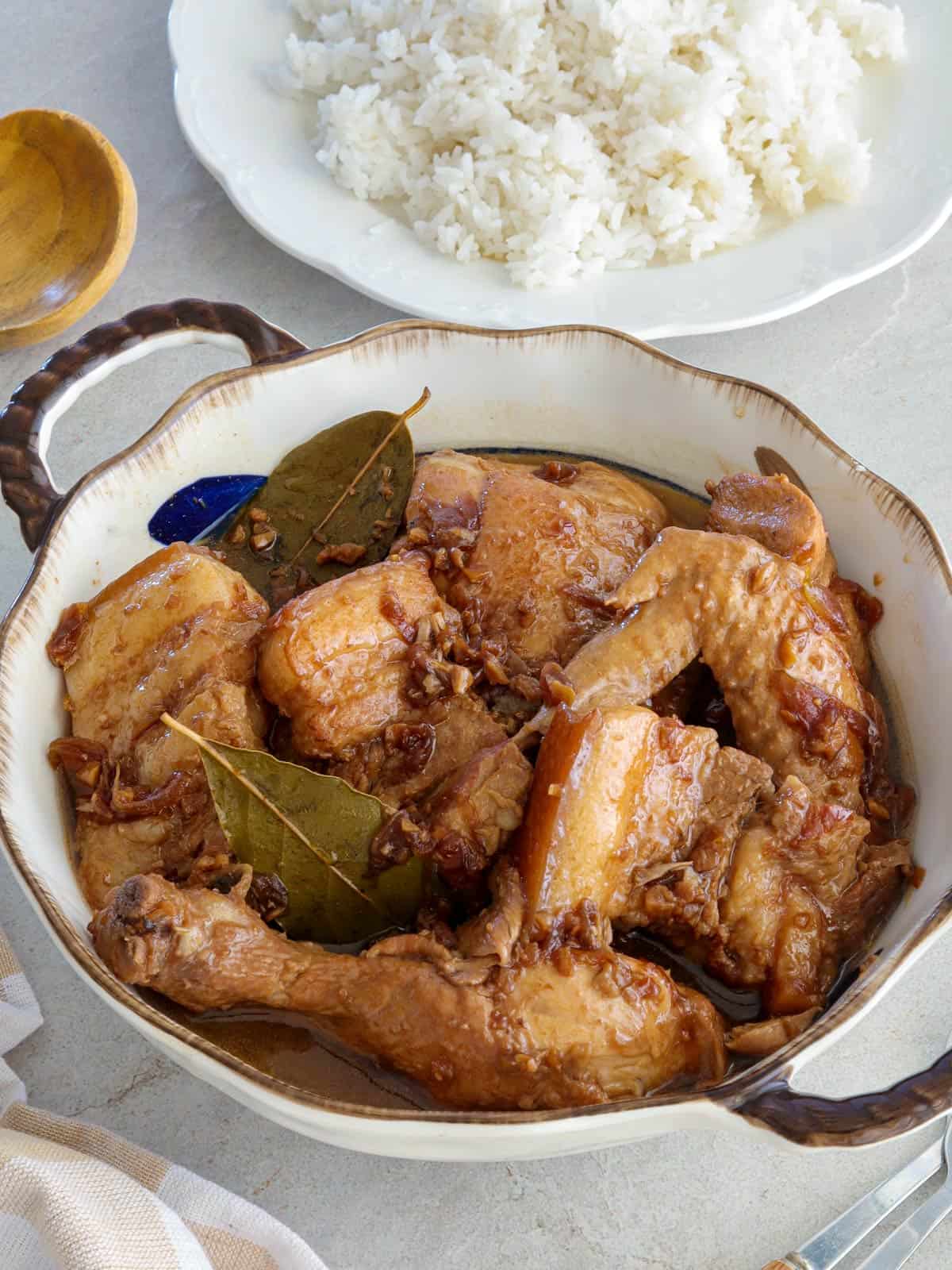Make dinner extra special with kare-kareng pata! It's quicker to make and more economical than its beef counterpart but is just as delicious. The melt-in-your-mouth pork, tender-crisp vegetables, and rich peanut sauce are sure to hit the spot!

One kitchen feat I consider my grand culinary victory is learning to make kare-kare from scratch. This uniquely Filipino dish is mostly reserved for special occasions and gatherings for good reason.
It is a laborious process, from tenderizing the meat, grinding rice, and toasting peanuts to making the sauce. But by employing simple tricks such as using rice flour and peanut butter, you can easily pull this pork kare kare into a delicious everyday dinner meal without resorting to commercial mixes.

Ingredient notes
- Pork- pata or pork shanks with a thick cap of fat simmered to melt-in-your-mouth tenderness work well with the rich peanut sauce. Pork belly and shoulder with skin are also good options.
- Vegetables- the recipe includes a mix of pechay, sitaw, and eggplant. You can also use Bagiuo beans, bok choy, and banana blossom.
- Rice flour- NOT glutinous or sticky rice flour! It's a convenient alternative to the traditional method of grinding rice grains. Make sure to toast in a dry skillet to bring out aroma and flavor.
- Peanut butter- be aware that some Philippine varieties are sweet and unsuitable for this recipe. Choose an unsweetened brand such as Skippy, or if you're shopping at a Filipino wet market, ask for peanut butter na pangkare-kare.
- Annatto powder- gives the stew its distinctive orange-red hue. If using annatto seeds, soak them in hot water to draw out the color and strain. Discard the seeds and add the colored water to the stew.
- Fish Sauce- adds umami flavor.

Cooking instructions
The procedure for this kare-kareng pata ng baboy is the same as the classic kare-kare and involves four main steps. Below is a quick rundown; check the recipe card for the full ingredient list and instructions.
- Simmer the pork until very tender. Add enough water to cover the meat, and add more in 1 cup increments during cooking to maintain about 7 cups of broth. Drain and reserve the broth for the peanut sauce.
- Toast the rice flour until lightly browned. Mix it with the annatto powder and about a cup of broth to make a slurry. This will thicken and add color to the sauce.
- Blanch the vegetables. Cook in boiling water or steam them until tender-crisp and immediately plunge in iced water to completely cool. This step will help keep their shape and bright color.
- Complete the stew. Saute the pre-cooked pata with onions and garlic. Season with fish sauce. Add the broth and thicken it with the flour slurry. Stir in the peanut butter and adjust the seasonings as needed. Add the vegetables and simmer until heated through.
Cook's tip
The skin around the hocks and shanks is rich in collagen, which becomes gelatin when cooked. Depending on the amount of gelatin in the broth, the peanut stew will congeal and set when cooled. The sauce will continue to thicken as it stands; feel free to adjust the amount of broth or water to desired consistency.

Serving suggestions
Kare-kareng pata is delicious as a main dish for lunch or dinner. Transfer to a serving bowl and garnish with ground peanuts, if desired. Serve with steamed rice and ginisang bagoong as a condiment.
Storage and reheating suggestions
- Let cool completely and transfer to an airtight container. Refrigerate for up to 3 days or freeze for up to 2 months.
- Reheat in a saucepan over medium heat, occasionally stirring to distribute heat. Add water or pork broth to loosen consistency and adjust seasonings as needed.
More pork stew recipes
Ingredients
- 3 pounds pork shanks, cut into 2-inch thickness
- 2 large eggplant, ends trimmed and cut into 1-inch thick
- 1 bundle long beans, sitaw, cut into 3-inch lengths
- 1 bundle pechay, ends trimmed and leaves separated
- ¼ cup rice flour
- 1 ½ tablespoons annatto powder
- 1 cup peanut butter
- 1 tablespoon canola oil
- 1 medium onion, peeled and sliced thinly
- 3 cloves garlic, peeled and minced
- 2 tablespoons fish sauce
- salt and pepper to taste
- shrimp paste
Instructions
- Rinse pork shanks under cold, running water. In a deep pot over medium heat, combine pork and enough water to cover. Bring to a boil, skimming any scum that accumulates on top.
- Lower heat, cover, and simmer, adding more water as needed to maintain 7 cups, for about 1 to 2 hours or until pork shanks are very tender but not falling apart. Drain meat, reserving 7 cups of broth.
- In a skillet over medium heat, add rice flour and cook, stirring occasionally, until lightly browned and toasted.
- In a bowl, combine toasted rice flour, annatto powder, and 1 cup of the reserved broth and whisk until smooth and well blended. Set aside.
- In a large pot over medium heat, heat oil. Add onions and garlic and cook until softened.
- Add pork shanks and cook, stirring occasionally, until lightly browned.
- Add fish sauce and cook for about 1 minute.
- Add the remaining 6 cups of reserved broth and bring to a simmer.
- Add rice flour mixture and peanut butter, whisking well to prevent lumps.
- Season with salt and pepper to taste.
- Continue to simmer for about 10 minutes or until sauce begins to slightly thicken.
- Meanwhile, in a pot over medium heat, bring about 4 cups of water to a boil. Add eggplant and blanch for about 1 minute. With a slotted spoon, remove from liquid and immediately plunge in a bowl of iced water.
- Add long beans and blanch for about 1 minute. With a slotted spoon, remove from the liquid and immediately plunge in a bowl of iced water.
- Add pechay and blanch for about 30 seconds. With a slotted spoon, remove from liquid and immediately plunge in a bowl of iced water.
- Drain vegetables very well and add vegetables to the kare kare. Continue to cook for about 3 to 5 minutes or until heated through.
- Arrange kare-kare on a serving platter and serve with sauteed shrimp paste on the side.
Notes
Video

Nutrition Information
“This website provides approximate nutrition information for convenience and as a courtesy only. Nutrition data is gathered primarily from the USDA Food Composition Database, whenever available, or otherwise other online calculators.”








Anne says
Very nice I tried all of your recipes it work for my family.
Maria says
The best
Ai says
I’m not sure why I thought you used annatto seeds in your video, so I bought to the seeds lol. Can you give me directions for annatto seeds instead? Thank you!
Kristine says
Hi Ms. Lalaine, what can I use in replacement of the rice flour?
Lalaine says
You can use regular flour if you don't have rice flour.
Esther says
Still no reply on my question?
Lalaine says
I am so sorry for the delayed response. Do you mind giving me the name of the recipe you submitted so I can check it out?
Esther says
Sinigang na Gabi (Taro). I'm waiting for yout reply because I still have other recipes that I want to send you. I know that you can give it more justice than I can 🙂 Perhaps you could even give it a nice twist to make it even more delish. To see the recipe on Kawaling Pinoy would really make me happy as well as my son who is also excitedly waiting to see it posted on your blog. I promised him that I will buy this toy (win or lose) that he's been asking me to buy him for a long time now for his upcoming 7th birthday if my recipe saw print on Kawaling Pinoy. Thanks for your reply.
Dinah says
I love Kare-Kare, unfortunately, hindi ko talaga magawa magluto nito. It always ends up like Sinigang 🙁
Esther says
Hi Lalaine. Just want to know if you got the recipe that I sent through the recipe contest? Thanks.